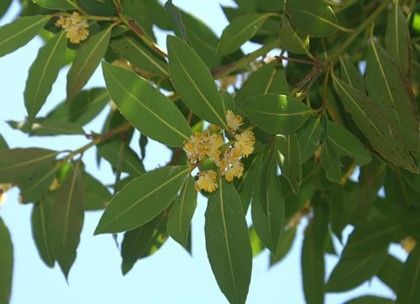Tuleyome's Science Corner - California Laurel

California laurel (Umbellularia californica) has a few aliases; it also goes by: bay laurel, California bay laurel, California bay, balm of Heaven, cinnamon bush, mountain laurel, myrtle, peppermint tree, spicebush… there are more…and historically, pepperwood.
The California laurel is native to California and southwestern Oregon and occurs in both the Coastal Range and the Sierra Nevada from San Diego County north into Southern Oregon. It is a member of the Lauraceae family and can grow as a single trunked tree or a multi-stemmed shrub. Young trees have smooth bark but as it grows, the bark begins to split and peel becoming scaly. In Northern California it flowers from about April through September and the fruit structure is similar to a peach, nectarine or an olive. They grow happily in a variety of habitats and do well in full sun or shade. California laurel occurs in humid coastal forests, oak woodlands, riparian, redwood and mixed evergreen forests as well as dry shrubland and chaparral. They are an evergreen but do experience some leaf drop in the winter or during drought conditions. The oblong, smooth leaves are thick and dark green and when broken or crushed release their magic - their wonderful scent.
Although the tree is beautiful, it’s probably best known for its aroma and medicinal properties. Many Native Americans including the Cahuilla, Chumash, Pomo, Miwok, Yuki and Salinan used the tree to treat various ailments. The leaves were often used to treat headaches, stomachaches, colds, sore throats, congestion, and when steeped in hot water used as an antiseptic for wounds and a remedy for head lice. The spicy leaves were also used as a seasoning and the fruit was dried and eaten while the seeds were roasted and then either eaten or pounded into a mash that was made into cakes and dried for later consumption. The leaves, twigs and shoots are very high in protein and a favorite of black-tail deer and the seeds are forage for scrub and stellars jays, dusky-footed woodrats and ground squirrels. The trees are fairly long-lived, aging out at approximately 200 years. One California laurel tree in Mendocino County is registered as a California Big Tree with a height of nearly 110 feet, a trunk circumference of almost 540 inches and a crown spread of almost 120 feet. The average size varies depending on habitat conditions, trees closer to reliable water grow larger faster. The California laurel is often used in riparian and wildlife habitat restoration and in flood control projects. The wood is used commercially for cabinets, trim and furniture and the burls are often carved into small objects and marketed as myrtlewood. They are often one of the first species to regenerate after a fire, sprouting from the roots and benefiting from increased seed germination.
Fun Fact - California laurel is in the same family as the avocado
Fun Fact - Dusky footed woodrats used California laurel leaves to keep fleas out of their nests
Not so Fun Fact - some people are severely allergic to the oils in the leaves
Next time you visit the newly expanded Berryessa Snow Mountain National Monument, keep an eye out for California laurel trees!
-Kristie Ehrhardt (kehrhardt@tuleyome.org)
Tuleyome Land Conservation Program Manager
RECENT ARTICLES






